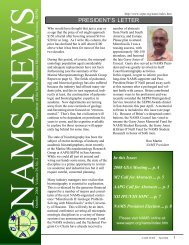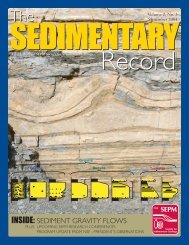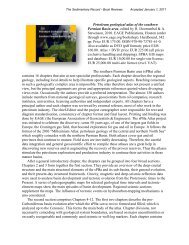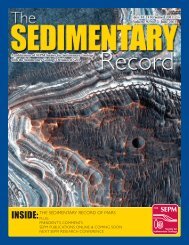PDF of contents and abstracts - SEPM
PDF of contents and abstracts - SEPM
PDF of contents and abstracts - SEPM
Create successful ePaper yourself
Turn your PDF publications into a flip-book with our unique Google optimized e-Paper software.
CARBON STABLE ISOTOPE COMPOSITION OF MODERN CALCAREOUS<br />
SOIL PROFILES IN CALIFORNIA: IMPLICATIONS FOR CO 2<br />
RECONSTRUCTIONS FROM CALCAREOUS PALEOSOLS<br />
NEIL J. TABOR AND TIMOTHY S. MYERS<br />
Roy M. Huffington Department <strong>of</strong> Earth Sciences, Southern Methodist University, Dallas,<br />
Texas 75275-0395, USA<br />
e-mail: ntabor@smu.edu<br />
ERIK GULBRANSON<br />
Department <strong>of</strong> Geosciences, University <strong>of</strong> Wisconsin, Milwaukee, Wisconsin 53201, USA<br />
CRAIG RASMUSSEN<br />
Soil, Water <strong>and</strong> Environmental Science, University <strong>of</strong> Arizona, Tucson, Arizona 85721, USA<br />
AND<br />
NATHAN D. SHELDON<br />
Department <strong>of</strong> Geological Sciences, University <strong>of</strong> Michigan, Ann Arbor,<br />
Michigan 48105-1005, USA<br />
ABSTRACT: Fourteen soil pr<strong>of</strong>iles from California were collected in order to measure the δ 13 C <strong>of</strong><br />
coexisting soil calcite <strong>and</strong> organic matter. Thirteen <strong>of</strong> the pr<strong>of</strong>iles contained a measurable amount <strong>of</strong><br />
calcite ranging from 0.04 to 54.6 wt %. Soil calcite δ 13 CPDB (δ 13 C value vs. the calcite st<strong>and</strong>ard Peedee<br />
Belemnite) values range from -14.4 to 1.3‰, whereas organic matter δ 13 CPDB values range from -24.0 to -<br />
27.7‰.<br />
The hydrology <strong>of</strong> these pr<strong>of</strong>iles is divided into two broad groups: (1) soils characterized by gravitydriven,<br />
piston-type vertical flow through the pr<strong>of</strong>ile <strong>and</strong> (2) soils affected by groundwater within the<br />
pr<strong>of</strong>ile at depths where calcite is present. The difference between soil calcite <strong>and</strong> organic matter δ 13 CPDB<br />
values, ∆ 13 C cc-om , is smaller in pr<strong>of</strong>iles affected by groundwater saturation as well as most Vertisols <strong>and</strong><br />
may be a product <strong>of</strong> waterlogging. The larger ∆ 13 C cc-om values in soils with gravity-driven flow are<br />
consistent with open-system mixing <strong>of</strong> tropospheric CO 2 <strong>and</strong> CO 2 derived from in situ oxidation <strong>of</strong> soil<br />
organic matter with mean soil PCO 2 values potentially in excess <strong>of</strong> ~20,000 ppmV at the time <strong>of</strong> calcite<br />
crystallization. There is a correlation between estimates <strong>of</strong> soil PCO 2 <strong>and</strong> a value termed “E PPT-U ”<br />
(kJm2/yr) among the soil pr<strong>of</strong>iles characterized by gravity-driven flow. E PPT-U is the energy flux through<br />
the soil during periods <strong>of</strong> soil moisture utilization, <strong>and</strong> it is the product <strong>of</strong> water mass <strong>and</strong> temperature in<br />
the pr<strong>of</strong>ile during the growing season. Thus, soils with high water-holding capacity/storage <strong>and</strong>/or<br />
low/high growing season temperature may form soil calcite in the presence <strong>of</strong> high soil PCO 2 , <strong>and</strong> vice<br />
versa. The results <strong>of</strong> this research have important implications for reconstructions <strong>of</strong> paleoclimate from<br />
stable carbon isotopes <strong>of</strong> calcareous paleosol pr<strong>of</strong>iles.






